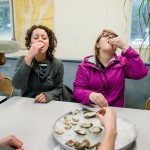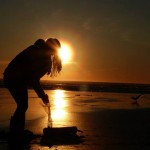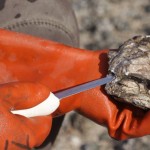Bibliography
Barton, A., Waldbusser, G., Feely, R., Weisberg, S., Newton, J., Hales, B., … McLaughlin, K. (2015). Impacts of Coastal Acidification on the Pacific Northwest Shellfish Industry and Adaptation Strategies Implemented in Response.Oceanography. The Official Magazine of the Oceanography Society, 28(2), 146–159.
Blake, B., & Ermgassen, P. (2015). The History and Decline of Ostrea Lurida in Willapa Bay, Washington. Journal of Shellfish Research, Published by National Shellfisheries Association,34(2), 273–280.
Brumbaugh, R., & Coen, L. (2009). Contemporary Approaches for Small-Scale Oyster Reef Restoration to Address Substrate Versus Recruitment Limitation: A Review and Comments Relevant for the Olympia Oyster, Ostrea lurida Carpenter 1864.Journal of Shellfish Research, 28(1), 147–161. http://doi.org/http://dx.doi.org/10.2983/035.028.0105
Bulseco, A. (n.d.). A Synopsis of the Olympia Oyster (Ostrea lurida).Aquaculture, 262.
Camara, M., & Vadopalas, B. (2009). Genetic Aspects of Restoring Olympia Oysters and Other Native Bivalves: Balancing the Need for Action, Good Intentions, and the Risks of Making Things Worse. Journal of Shellfish Research, Published by National Shellfisheries Association, 28(1), 121–145.
Dumbauld, B., Kauffman, B., Trimble, A., & Ruesink, J. (n.d.). The Willapa Bay Oyster Reserves in Washington State: Fishery Collapse, Creating a Sustainable Replacement, and the Potential for Habitat Conservation and Restoration. Journal of Shellfish Research, Published by National Shellfisheries Association,30(1), 71–83.
Eissinger, A. (2009, June). Marine Invasive Species Identification Guide for the Puget Sound Area. Puget Sound marine Invasive Species Volunteer Monitoring Program. Retrieved fromhttp://www.psp.wa.gov/downloads/ANS/MISM_Online.pdf
Ginger, K., Vera, C., Dineshram, R., Dennis, C., Adela, L. J., Yu, Z., & Thiyagarajan, V. (n.d.). Larval and Post-Larval Stages of Pacific Oyster (Crassostrea gigas) Are Resistant to Elevated CO2. The Swire Institute of Marine Science and School of Biological Sciences. Retrieved fromhttp://journals.plos.org/plosone/article?id=10.1371/journal.pone.0064147
Harding, J. (2002). Shellfish Stalkers: Threats to an Oyster. Virginia Institute of Marine Science. Retrieved fromhttp://www.vims.edu/GreyLit/VIMS/EdSeries53.pdf
Jacobsen, R. (2008). A Geography of Oysters: The Connoisseur’s Guide to Oyster Eating in North America (First). Bloomsbury USA. Retrieved from http://www.amazon.com/Geography-Oysters-Connoisseurs-Oyster-America/dp/159691548X
Native Oysters. (n.d.). Retrieved fromhttp://www.partnershipforcoastalwatersheds.org/native-oysters/
Nuwer, R. (2014, May 6). Five Parasitic Species People Love to Eat.Smithsonian Magazine. Retrieved fromhttp://www.smithsonianmag.com/smart-news/five-parasitic-species-some-people-love-eat-180951340/?no-ist
Ocean Acidification. (2014).
Oyster Biology & Ecology. (n.d.). Retrieved fromhttp://score.dnr.sc.gov/deep.php?subject=2&topic=15
Pellegrini, G. (2010). Finding the Beautiful Taste. In Food Heroes: Sixteen Culinary Artisans Preserving Tradition (p. 240). Stewart, Tabori and Chang. Retrieved fromhttp://www.amazon.com/Food-Heroes-Culinary-Preserving-Tradition/dp/1584798548
Polson, M., & Zacherl, D. (2009). Geographic Distribution and Intertidal Population Status for the Olympia Oyster, Ostrea lurida Carpenter 1864, from Alaska to Baja. Journal of Shellfish Research, 28(1), 69–77.
Pritchard, C., Shanks, A., Rimler, R., Oates, M., & Rumrill, S. (2015). The Olympia Oyster Ostrea lurida: Recent Advances in Natural History, Ecology, and Restoration. Journal of Shellfish Research, 34(2), 259–271. http://doi.org/http://dx.doi.org/10.2983/035.034.0207
What are pea crabs and why are they in my oysters? (2015, May 1). [Business]. Retrieved fromhttp://www.pangeashellfish.com/blog/what-are-pea-crabs-and-why-are-they-in-my-oysters
White, J., Ruesink, J., & Trimble, A. (2009). The Nearly Forgotten Oyster: Ostrea lurida Carpenter 1864 (Olympia Oyster) History and Management in Washington State. Journal of Shellfish Research, Published by National Shellfisheries Association,28(1), 43–49.




